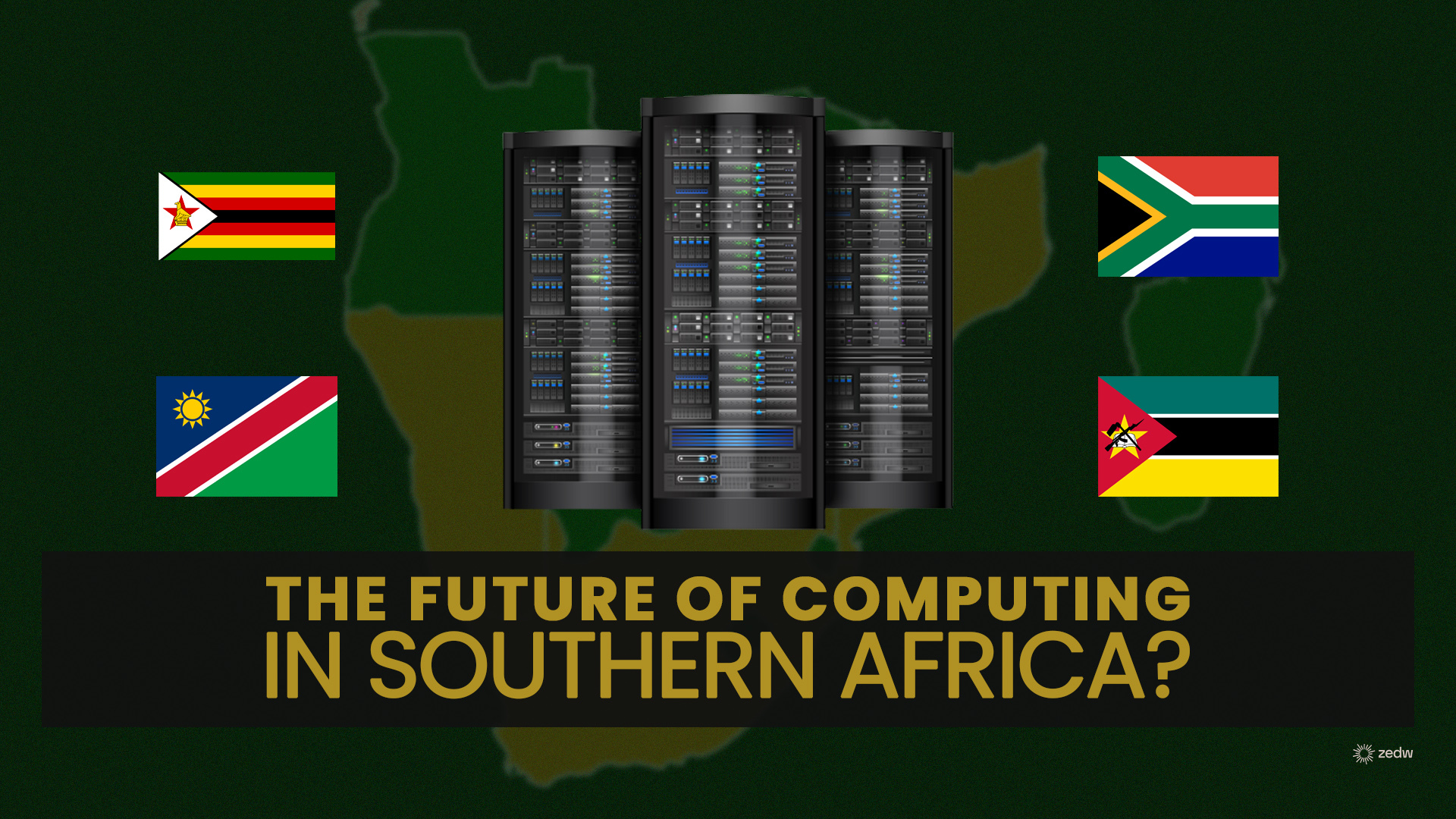From climate change mitigation strategies to personalised medicine needs, southern Africa faces complex challenges. The “developed” world has been using technology and high-performance computing (HPC) to solve such problems and thus the question arose – are HPCs being utilised in Africa and to what degree are we reaping the benefits of this technology?
HPCs as a concept are still quite novel in Africa and so we will take a “first principles” approach and start by outlining the concept along with highlighting some of the breakthroughs achieved globally. This will illustrate the usefulness and potential of HPC and then we will explore what’s happening in Southern Africa.
What’s the fuss around High-performance computing?
High Performance Computing generally refers to a practice of aggregating computing power to deliver much higher performance than one could attain out of a typical desktop computer or workstation in order to solve complex problems in science, engineering, weather forecasting, simulations, or any field of concern. What this means for example is that if a problem takes 18 hours to solve on the computers we are used to working with – it would take an hour on an HPC (depending on many different variables of course).
High Performance Computing (HPC) services offered by supercomputers have been described by the European Union as “critical for; i) discovering new drugs, ii) speeding up the diagnosis and treatment of diseases, iii) anticipating severe weather conditions, iv) increasing cybersecurity and v) developing more sustainable products.”
The EU went ahead and created the European High Performance Computing Joint Undertaking (EuroHPC JU) in 2018. This joint initiative pools together resources from the EUs 31 states and 3 private partners with the goal of “making Europe a world leader in supercomputing.”
Whilst that illustrates the broader use cases and hype around high performance computing it still doesn’t plainly outline what solutions in this domain look like in the practical world. A few examples of complex solutions that have relied on high performance computing include;
- Personalized Cancer Treatment: HPC allows doctors to analyse a patient’s entire genetic makeup alongside their medical history. This enables them to create personalised treatment plans that target the specific mutations driving the cancer. This approach has led to improved patient outcomes and even the development of entirely new cancer therapies.
- More Accurate Weather Forecasts & disaster response: HPC allows meteorologists to run complex weather models that factor in a multitude of variables. This leads to more accurate and detailed forecasts, enabling better preparation for extreme weather events. The US National Weather Service uses HPC to predict hurricane tracks with much greater accuracy than ever before. The EU has ESIWACE3 for addressing efficient and scalable simulations for earth system modelling, weather, and climate prediction and they allocate 6 million euros to it (50% came from the EU).
- Optimising Energy Production: HPC helps model and optimise energy production from renewable sources like solar and wind. This allows engineers to design more efficient power plants and integrate renewable energy sources more effectively into the grid. The EU has the EoCoE-III project which demonstrate the benefit of HPC for the net-zero energy transition for research institutes and also for key industry in the energy sector.
- Aeroplane development: Design of the A380 would have been impossible without HPC to simulate airflow over the structure and the combustion processes in the engines. Similar airflow programs are used in motorsports like Formula 1.
The above are a few examples of high-performance computing use cases but that begs the question, what is going on closer to home? Is the SADC region making strides in this domain or are we lagging behind like we currently are in Artificial Intelligence readiness?
High performance computing in the SADC region
Most HPC efforts within the region are attributable to South Africa’s Centre for High Performance Computing (CHPC). The founding of the CHPC was largely tied to solving a problem astronomy researchers were facing.
South African Radio Astronomy Observatory played a pivotal role in the development of the Square Kilometer Array (SKA) – an international effort to build the world’s largest radio telescope. This telescope would allow “astronomers to monitor the sky in unprecedented detail and survey the entire sky thousands of times faster than any system currently in existence.”
The problem with building such a telescope is that the data demands are extremely high. Bryan Johnston, a Senior HPC Technologist at the CHPC described the task as similar to “cloning the internet every day”. In more practical terms – back in 2014 at its inception SKA was expected to be generating an estimated 2.5 petabytes of data every second. The CHPC was established to help process this data in real time. This burning need coupled with the desire to build out supercomputing capacity is what essentially led to the formation of the CHPC in South Africa.
The CHPC proceeded to obtain 20 Ranger high performance computers that had been decommissioned in Europe but were still ranked 50th fastest in the world and brought them to South Africa. The hardware was distributed to 5 sites across South Africa.
Wits University has been one of the big beneficiaries of the CHPC’s efforts to drive high performance computing adoption within the region – as the education institution is home to 3 HPC systems;
- Wits Core Cluster – Used for Big Science, Medicine and bioinformatics
- CrunchYard – used by commercial code users, commercial users and advanced UI
- MSCluster – used for teaching, honours, masters and pHD research
Namibia and Mozambique
By August 2023, the CHPC had 33 sites across Africa (16 in South Africa as of mid-2023) and the presence of high performance computers distributed by CHPC has spread to include countries like Mozambique and Namibia – most of whom received repurposed Ranger computers from the CHPC. Let’s explore Namibia’s case first:
“The primary use of the rack was foreseen to be human capacity development and awareness in HPC and to form part of Namibia’s readiness in participating in the Square Kilometre Array (SKA) and the African Very Long Baseline Interferometry Network (AVN) projects, but is now also being used for research in multi-wavelength astronomy and beyond.” – Namibia’s first high performance computer | Jimmy Shapopi, Anton Limbo and Michael Backes
Namibia received its first 4 high performance computer racks from the CHPC in between 2016 and 2019 with the hardware being hosted at University of Namibia (UNAM) and Namibia University of Science and Technology (NUST). As mentioned above the broader goal was to have Namibia participate in processing data generated by the SKA telescope but beyond this there has been localised usage:
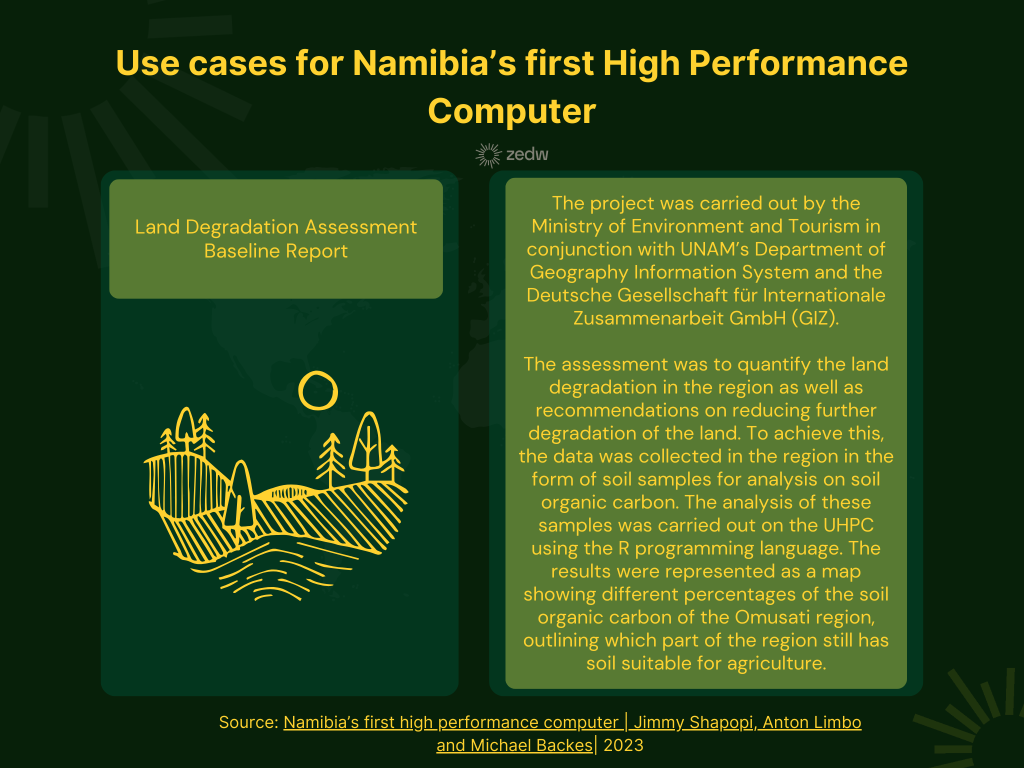

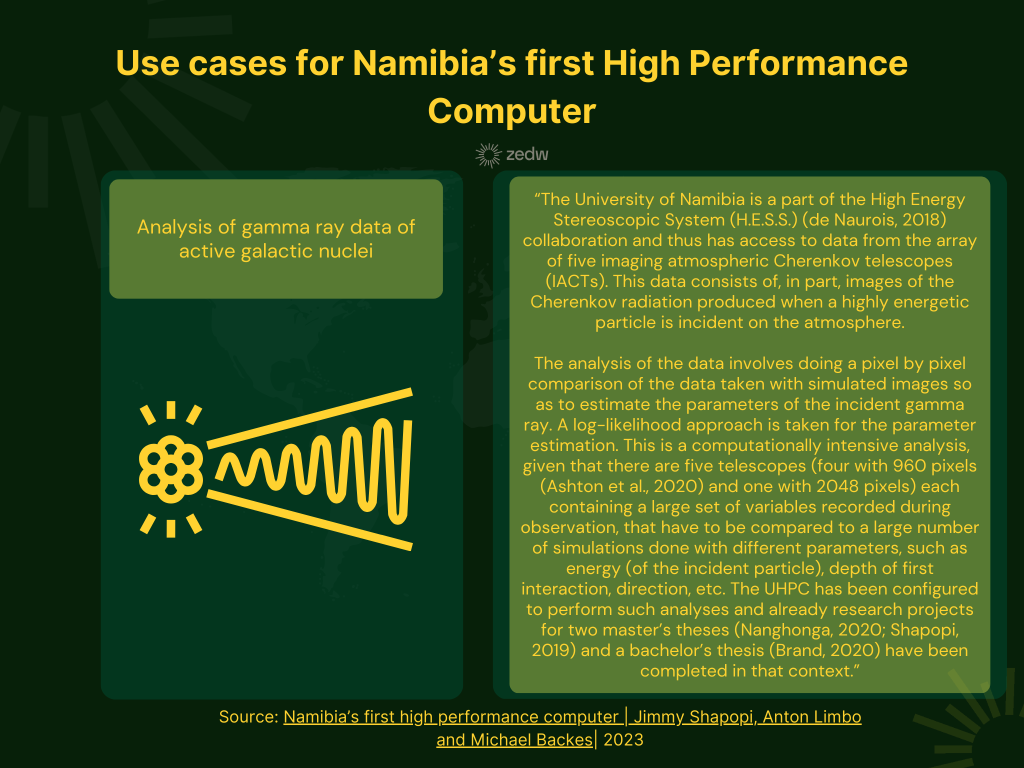

In Mozambique, most of the progress has taken place at MoRENET (Mozambique Research Network) and a presentation by Berny Chaimite – a system administrator at the research organisation shed more light on the efforts being made in the country.
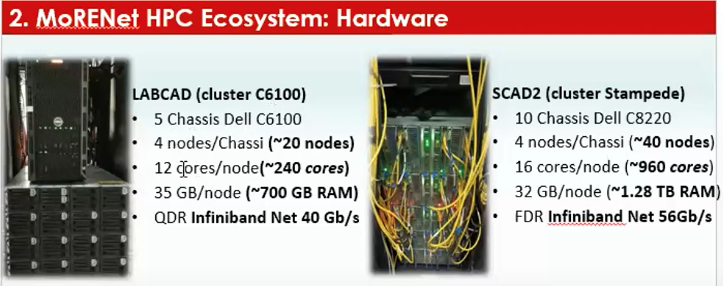
The HPC hardware was delivered to Maluana National Data Centre and made operational in 2019.
MoRENET’s goals in HPC were motivated by providing computing services for academic and research institutions based in Mozambique. The high performance computing program had a bunch of broad goals:
- Facilitate scientific research/discoveries aligned with sustainable development;
- Support scientific research that apply models for simulations of phenomena in several scientific domain;
- SKA project development; modernizations of meteorological/hydrological services, Health and Energy sector
We managed to get a glimpse of some of the approved projects and use cases for the high-performance computers in Mozambique:
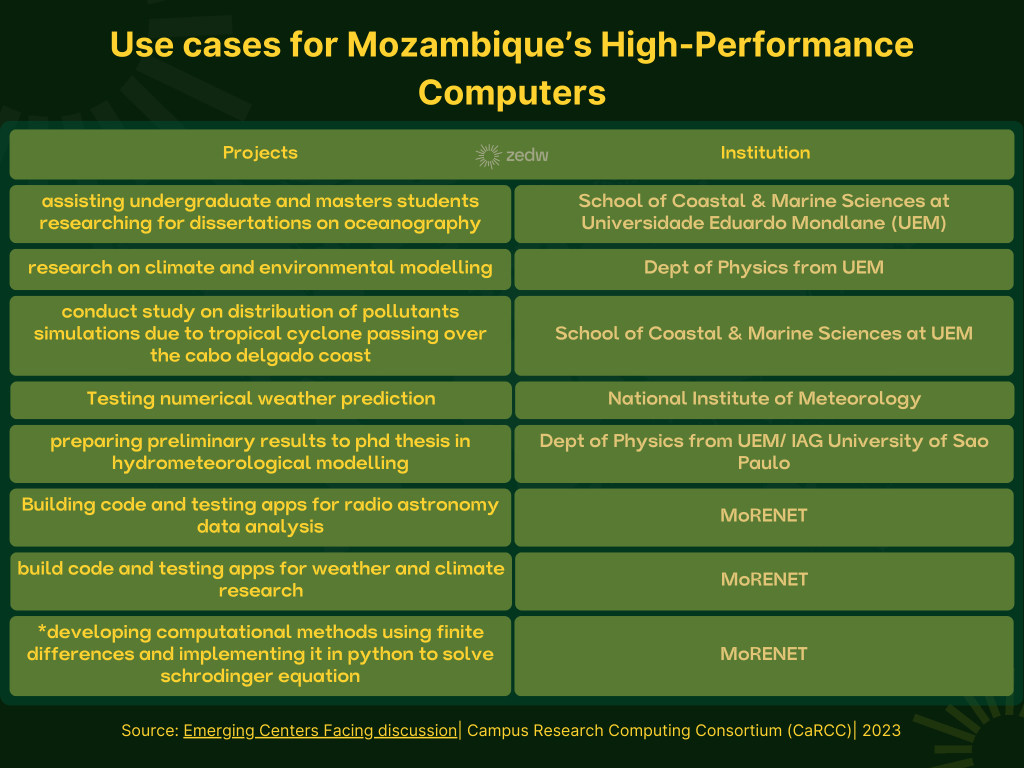
Zimbabwe
In Zimbabwe the HPC story is a bit different as there hasn’t been any recorded mention of the CHPCs involvement in the technologies adoption. The Zimbabwe High Performance Computing Project was conceived in October 2011 and HPC was identified as one of the key solution to assisting the nation, region and beyond in solving challenges associated with climate change, food security, unclean water, poverty, diseases, energy and human capital development. The implementation process took less than a year as it started on the 16 May 2014 and commissioned on the 6th February 2015 for an estimated cost of US$5.4mn.
The centre is located at the University of Zimbabwe and the organisation’s mission statement is “development of an accessible and sustainable cyber infrastructure that supports and accelerate national and regional research, development and innovation capabilities for socio-economic development.”
A research paper by the title Analysis on the Adoption of High-Performance Computing by State Universities: A case of Zimbabwe by Dr Belinda Mutunhu, Dr T.Nyathi and Dr Sibusisiwe Dube mostly revealed challenges hindering HPC adoption and was published in 2021. The paper was published with the intention of solving the access to information gap around HPCs which we will explore in latter sections of this piece.
In regards to use cases there is limited information highlighting what the HPCs have been used for locally. We know that ZCHPC entered an agreement with Afrosoft – a local company- that would see the two collaborate on research development and knowledge exchange.
In 2022 the first National Students Cluster building Competitions were held as a pilot program which would see 8 national universities pitted against each other. The competition saw students trained on various use cases of HPCs in order to build capacity in the under-accessed domain.
Some of the challenges with HPC adoption in the context of Zimbabwe included limited access as people intending to make use of the hardware have to make their way to Harare.
This was compounded with awareness issues which include – people having a hard time grasping the interface of the HPC which at the time was indicated to run on Linux RHEL 6.4. This lack of awareness extended to people not knowing how to use the HPC which would then be aggravated by no documentation support, and inadequate training.
Finally, lack of dedicated staffing has also been cited as a problem with HPC users getting limited to no feedback whenever they ran into problems.
Ultimately the paper suggested that the following be done to improve adoption of HPCs locally;
- Building out a graphical user interface in order to ensure that users without linux knowledge can use the hardware without learning the command interface;
- Hold more workshops, trainings and seminars on importance of HPC in research;
- Hire more technical staff to help users who run into problems with the HPCs (at the time 2 engineers were responsible for support)
- Increase awareness of HPCs in the universities – at the time ZCHPC was reliant on word of mouth which had been ineffective in raising interest;
- Provide documentation support for download;
- Sponsor an HPC prize for undergraduate and masters students who use HPC in their final year programs to encourage use;
- Create a women’s HPC forum to increase female participation.
All these points are quite poignant and do indicate broader regional issues though it’s hard to determine to what degree as HPC centres within the region make it hard to access information as we will talk about in the next section.
Regional challenges and gaps
Whilst high performance computing is beginning to sprout across the region there are quite a few challenges holding adoption and usage back at this moment.
In the research we did to track some of the current progress it became apparent that there isn’t enough information that is publicly accessible in regards to high performance computing in the region. Whilst many of the organisations involved with HPCs believe the government should take a more active interest in this industry – it will be hard to do so if people don’t know what HPCs are or why they are valuable to a nation. It’s therefore incumbent on these communities to make it easier for people working within the media and the rest of the general populace to know the work they are doing and why it is important.
This information access gap was so big that when CHPC initially started giving out hardware – people who didn’t even know what high performance computing was went and took systems thinking they would be able to run Windows or Linux on the machines and later finding out it wasn’t the case. CHPC later fixed this flaw by conducting evaluations for hardware recipients but only after machines had gone to recipients and found no use a couple of times.
Beyond information access, there is also a huge talent gap which has been particularly hard for emerging communities to solve. The problem is even more layered because even those who’ve received training have sometimes gone on to leave the community for better jobs leaving that gap again;
“We’ve got guys for example, (and this is just an anecdote. It’s not a true event). They’ve studied and developed some HPC skills from our training and bigger companies reach out to them. We had people move from all these institutions to get better jobs and that’s not a loss because that was one of our goals to train expertise in HPC but half of them didn’t keep it in HPC. They went into enterprise cloud and things like that. So we lost them and then the other side of it is that we had to train new people up. That was kind of a good problem to have but it was a frustrating problem.“
Bryan Johnson, a Senior HPC Technologist at the CHPC
This talent gap has been a commonly cited problem in most of the regions where HPCs are popping up and something will have to be done if the region is going to get the most out of the hardware.
The talent gap ties closely to another problem which is government involvement or lack thereof. It’s not surprising that most of the progress we’ve explored in this essay has been centred around the CHPC in South Africa – which has close ties to the Council for Scientific and Industrial Research (CSIR). Government funding in this regard guarantees jobs and hardware which in turn can result in progress in research and an incentive for individuals within the region to learn these skills as they can then find work.
Happy Sithole, the centre manager for the National Integrated Cyber Infrastructure System at the CSIR did highlight that there’s a chicken and egg problem as the government needs convincing but the hardware is in some ways also needed to convince the government;
“It’s not an easy thing to convince the government to put money into what they may see as toys for scientists. So the first thing is to look at what you can solve in terms of tangible things in the country. When we [CSIR] got the seed funding we looked at what are some of the strategic initiatives in the country, what are the pain points and can we take them and use high performance computing to solve them.”
Happy Sithole – centre manager for the National Integrated Cyber Infrastructure System at the CSIR
The executive also made the poignant statement that sometimes government investment can be hard to secure because governments’ traditionally have short lifespans (4-5 years) and therefore if the impact of the projects can’t be demonstrated quickly, funding might not be available.
Outlook
Whilst it’s clear that activity within the region is still in its formative stages – there’s a bit of a wildcard that could end up accelerating adoption of HPCs. The sudden rise to prominence of AI over the last 18 months has meant that most regular people are now starting to interface with the products of HPCs. AI readiness is becoming a conversation at the forefront of many industries and no one is spared and perhaps adoption of HPCs in the region might be motivated by this technology and then the broader use cases are discovered once the hardware is here.
It is important to note though – that such an outcome might be overly optimistic as there are only two countries in the region with AI strategies (South Africa and Mauritius) at the moment. As with most things that are technology-adjacent our region is lagging behind in high performance computing and will continue to be so for the considerable future

